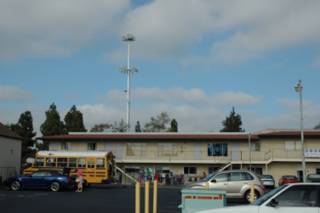San Diego CHP & Caltrans comm center

San Diego CHP & Caltrans communications center. Nice HF log periodic antenna for backup when microwaves can't get through the smog & smoke ;-)
FCC limits antennas on historical sites
RCR Wireless News: The FCC has adopted rules to restrict placement of antennas upon historical resources. "The FCC recognized that, as the number of tower constructions around the country has dramatically increased since the late 1990s, it has a responsibility to manage the expansion of communications infrastructure in a way that best preserves our nation's historical resources", said the commission. Commissioners Abernathy and Martin partially dissented, questioning the FCC's authority under the the National Historic Preservation Act.
Multiple-in, multiple-out (MIMO) antennas for wi-fi
New Wi-Fi standards (802.11n) will likely include Multiple-in, multiple-out (MIMO) antennas for 100 Mbps throughput and increased range.
Network Magazine | Boosting Wi-Fi With MIMO and 802.11n | August 1, 2004: "Multiple-In, Multiple-Out (MIMO), which is likely to be 802.11n's foundation"
Raining Satellite Dishes in Bahamas this AM
It was raining satellite dishes in Nassau last night when hurricane Frances hit. The popularity of direct broadcast satellite dishes, half-assed self-installation, large wind profile, and flying saucer aerodynamics combined to create quite a mess.
ABCNEWS.com : Hurricane Frances Hits Bahamas
Mobile HF antenna on CDMAONE

A hitch-mounted amateur radio high frequency (HF) antenna. Note "CDMA ONE" license place. Qualcomm employee?
Stealth Flagpole antenna

Stealth flagpole antenna on the west side of the 163 freeway South of Friars Road. On the Remington College "Campus". Note radome housing antennas at top. What happens when the flag gets wet? Reduction of signal in direction of the wind? Well, it never rains in San Diego anyway.


Looking up from base.

The base of the flagpole antenna.

This one is a "Minimum Visual Impact Structure" manufactured by
Valmont . They also make stealth palm tree, pine tree and cactus antennas.
Utility Pole Antennas
A toddler, a baby and a puppy. They all do better when you take them outside for a walk from time to time. It's amazing the things you notice walking. Walking instead speeding at 40 MPH through your 25 MPH neighborhood. I've been noticing antennas.
Lets begin our little journey with telephone poles. Ok, utility poles. They are now sprouting antennas of various types. We are really loading up these poor, dead, tar-covered trees.
The photos below were taken within a 1 mile stretch near Palos Verdes Drive North in Palos Verdes Estates, CA.

Cellular sector antennas (painted brown) pointing at Palos Verdes Country Club and Palos Verdes Dr. N. Also note the three small white antennas and radio connected directly to cable. I believe this is an "old"
Cox communications PCS cell. Cox Communications sold their PCS business to Sprint. These Cox cable-attached trio antennas are everywhere around Palos Verdes Estates. I suspect they are not in use. Anyone know the story?
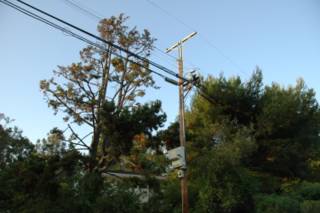
Sector antennas aimed at Palos Verdes Drive North. I believe this is Sprint wideband PCS. Also see what looks like an old
Ricochet antenna above the PCS antennas.
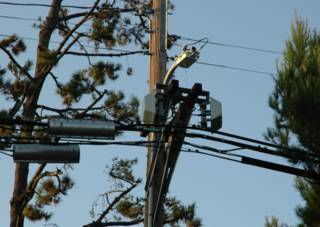
Close-up
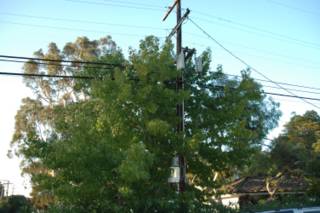
This pole is between two houses, within four feet of a driveway. It might be worth changing wireless providers when there is a cell in your front yard.

Close-up. Time to trim the tree.
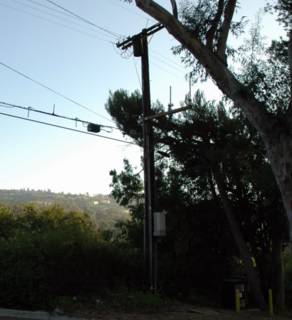
This picture is a bit underexposed, but you can see the silhouette of the two Sprint PCS isopole antennas on the right side of the pole and the three old Cox antennas on the cable to the left. This is a Sprint PCS site. There is a phone number for the Sprint Network Operations Center (NOC) on the equipment.
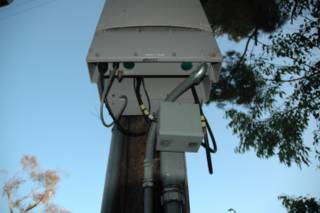
Close-up of the radios mounted on the pole at a height of 7'. I'm surprised by how vulnerable this cell site is. RF cabling is exposed within arm's reach.
So, I'm not surprised to see so many of these micro cells popping up, that was always the vision for cellular communications systems... smaller, lower-level cells as the needs for capacity grow. I am surprised by how physically insecure these cells are. I am surprised that the antennas have trees in their radiation path, that's a problem at 1.9GHz. I guess the cellular providers just have to live with trees in residential areas.















